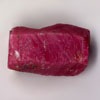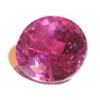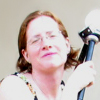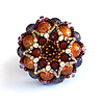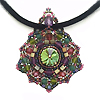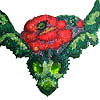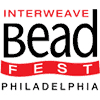July, 2008

From MyLovelyBeads.com TeamHenry Longfellow, a great American poet, wrote, "O summer day beside the joyous sea! O summer day so wonderful and white, So full of gladness and so full of pain!" In July's issue:
Ruby - precious stone
Contact us with any questions at
info@mylovelybeads.com.
Beaded beads by Gwen Fisher Featured artist - Valerie Tournie The Bead Museum in DC Free-form beaded jewelry Step by step - Raspberry August upcoming events Best regards,
MyLovelyBeads.com Team |
Ruby - precious stoneJuly, as all months, has more than one birthday stones. The first one is carnelian, you can read about that gemstone in the July, 2007 issue of our newsletter. The second gem is a ruby, a light pink to blood red stone. Ruby is a variety of the mineral corundum and is considered one of the four precious gems, with the sapphire, the emerald, and the diamond. Its name comes from RUBER (RUBENS, RUBINUS), Latin for red. All natural rubies have imperfections in them, including color impurities and inclusions of rutile needles known as "silk". Gemologists use these needle inclusions found in natural rubies to distinguish them from synthetics, simulants, or substitutes. Usually the rough stone is heated before cutting. Almost all rubies today are treated in some form, with heat treatment being the most common practice. Some rubies show a 3-point or 6-point asterism or star. These rubies are cut into cabochons to display the effect properly. Asterisms are best visible with a single-light source, and move across the stone as the light moves or the stone is rotated. Such effects occur when light is reflected off the silk (the structurally oriented rutile needle inclusions) in a certain way. This is one example where inclusions increase the value of a gemstone. Rubies can furthermore rarely show color changes and chatoyancy. Rubies are mined in Myanmar (Burma), Thailand, Sri Lanka, Tanzania, Kenya, Madagascar, Cambodia, and Russia (Siberia), but they have also been found in the USA (Montana, North Carolina and South Carolina). The Mogok Valley in Upper Myanmar has produced some of the finest rubies, but in recent years very few good rubies have been found there. The unique color in Myanmar (Burmese) rubies is described as "pigeon's blood". They are known in the trade as "Mogok" rubies. Although pieces of red corundum can be found weighing many kilograms, they are generally not of sufficient quality to be valuable as gemstones. For this reason, auction prices are the best indicator of a stone's true value, and prices correlate not only with size, but also with cut, origin, clarity and quality. Rubies have always been held in high esteem in Asian countries. They were used to ornament armor, scabbards, and harnesses of noblemen in India and China. Rubies were laid beneath the foundation of buildings to secure good fortune to the structure. Ruby is considered to be a stone of passion. It's thought that when used properly, the negative aspects brought to the surface, will be dispelled. Zodiac signs of the ruby are: Cancer (Crab), Sagittarius (Archer), Leo (Lion). Ruby facts 1. The famous lighted "Red Stars" mounted above Kremlin (Moscow, Russia) spires, thought to be giant rubies mined in Siberia, are colored glass. 2. An early recorded note of the transport and trading of rubies arises in the literature on the North Silk Road of China, where in about 100 BC rubies were carried along this ancient trackway moving westward from China. 3. Ruby is the most commonly named precious stone in English translations of the Bible 4. The Smithsonian's National Museum of Natural History in Washington DC, has received one of the world's largest and finest ruby gemstones. The spectacular 23.1-carat ruby was mined from the famous Mogok region of Burma (now Myanmar) in the 1930s, and set in a platinum ring with diamonds. 5. As of 2006, the record price paid at auction for a single stone was $5,860,000 for an unnamed 38.12 carat cabochon-cut ruby. |
|
Beaded beadsInterview with beadwork artist Gwen Fisher The name of Gwen Fisher (California, USA), a mathematician and a beaded bead designer, is well known as the name of one of the most creative artists. She inspired a lot of beaders with her three-dimensional designs. The questions for this interview were collected by us on a Russian beaders' forum, where we opened a special topic for that, and every visitor could leave his question to Gwen Fisher. We picked up 18 best questions, and Gwen was so kind that she agreed to answer all of them! Thank you, Gwen! 1. When and how did you start beading? I started weaving beads the first time in my early twenties, but all I did was stringing, fringe, and daisy stitch. Eventually, I got bored and switched to painting, and then quilting. I really took up bead weaving 2003. There was a seed bead shop two blocks from my apartment, and the owner of the shop had a case full of beautiful beaded objects designed by many famous designers. I was captivated, and I wanted to learn how to make some of the pieces, especially the beaded beads. So, I bought a few beads, books and magazines, and I taught myself to weave beads. 2. Who were your teachers in beading? Who inspired you first? I have never taken a beading or jewelry making class. I learned beading from books and studying photos from websites. My early inspiration came from Carol Wilcox Wells, Sharri Moroshok, Christine Prussing, and Takako Samejima. 3. What was your first beaded item? Do you know where it is now? I don't remember what my first beaded item was, but my first beaded bead looks like a lumpy, lopsided raspberry made from brick stitch. It's in my bead box with all of my other ugly beaded beads. 4. What kind of beading technique have you tried? Why did you choose beaded beads? I've tried almost all of the common off-loom bead stitches done with a needle and thread: peyote, brick, herringbone, and spiral stitches, to name a few. My bead box is full of little samples of these. Beaded beads are my favorite projects for several reasons. First, they are little treasures that I can finish in less than a day. Second, discovering new beaded bead designs seemed like a natural and challenging application of the math I love. Since I had been an avid quilt artist for the decade before I started bead weaving, I had plenty of time to fiddle with two-dimensional ideas that I could make with flat fabric. The three-dimensional nature of beaded beads gave me a whole new realm of mathematical ideas to explore. To me, weaving a beaded bead feels like solving a puzzle, and then I have a piece of jewelry when I'm done. Finally, I find something magical about a sparkly bead cluster woven entirely out of beads.
Full interview with Gwen Fisher
|
|
Featured artist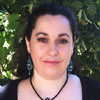
Valerie Tournie is a crystal and seed bead jewelry designer from France. When she was a teenager of about 14 years, she discovered Brazilian bracelets that looked like macrame. She felt that it would be possible to create such jewelry using seed beads weaving, but this technique was unknown in France in the late 80's. Anyway, she tried to make a few simple rings in that style. She did further research and found one of the first fashion collections of Christian Lacroix, a great French fashion designer, who created a complete range of old vintage-looking jewelry, inspired by Provence and South East French culture. Valerie's dream was to make romantic jewels as in fairy tales, or close to Christian Lacroix's style. At that time she didn't know anything about beading techniques, so she put aside her work, keeping in her mind all those beautiful designs. Actually, she first tried beading at the end of 2005. She found beaders' forums and her new friends helped her find books and bead suppliers. Looking at the stunning work of some bead artists she was thinking, "How could I do anything like that?" She bought a book by a well known French beaded jewelry designer, Marie Le Sueur, and another book by a French bead artist, Marie Geraud. Valerie took so much knowledge from these two books, that she felt she could start to create her own designs and patterns of a "baroque" style, which became her beadwork signature. Valerie has got two free projects in her blog: an earrings pattern called "Inca" and another one called "Fleur". You may find them in the blog under title "Faire des Luzioles", that means "Doing some Luzioles". "Luziole(s)" is the global name given to my creations. This name comes from Luz, Valerie's nickname, and the French noun "luciole", that means fire-fly or glow-worm. "Luz" also means "light" in Spanish. Besides, there is a little river in France, close to the Pyrenees Mountains on the border of France and Spain, where Valerie Tournie lives. "Lucioles" became "Luzioles", because her jewels are lightening in the dark!
The full article on jewelry making by Valerie Tournie
|
|
The Bead Museum in DCThe Bead Society of Greater Washington and The Bead Museum together are dedicated to furthering the understanding and appreciation of beads - personal ornaments that not only express human aesthetic impulses but embody deep symbolic significance, and are among mankind's earliest, most universal, and most enduring creative achievements. The Bead Museum promotes cultural understanding through the interpretation of beads. The museum address is:
The Bead Museum
This year The Bead Museum DC presents the 1st Annual
International Juried Jewelry Design Competition.
Officially launched on December 1st, 2007, this
international contest is open to everyone from the
professional to the hobbyist to the student. There
are 12 media categories for the contestants to enter.
Winners will be announced at the Bead Society of
Greater Washington's 2008 Bead Gala on September
20th, 2008 at the Navy Memorial Naval Heritage Center
in Washington, DC, located across the street from
the Bead Museum.
The Jenifer Building 400 Seventh Street Northwest, Ground Floor Washington, DC 20004 |
|
Free-form beaded jewelry
Valentina Chertikovtseva, who has been an artist and crafter all of her life, shares with us her beautiful beadwork. A native of the USSR and currently residing in Israel, she began with sewing, knitting and crocheting both clothing and eventually toys as well. Upon her move to Israel she began to also make toys using fabrics and in her research on toy-making came upon a book about beaded toys. This is where her inspiration for beading began. Once she began beading, she expanded her work to include beaded flowers - which is now her favorite theme for all of her work. She then learned to do bead embroidery and her rich imagination has led her to dream up and improvise to create her own, unique style of work. Much of her work is very bright, but Valentina has also said that she very much enjoys creating pure white, icy items which focus more on shape than color. Valentina continues to expand her work and techniques in order to keep making beautiful jewelry. Her motto is now "No day without beads." We hope you too, can adopt this motto and enjoy all of the beds from all of our artists. Valentina's work in our gallery: free-form beaded jewelry. Contact Valentina at valyasher@yandex.ru. |
|
Step by step - RaspberryWe naturally assume that beadwork is a women's hobby, and you may be surprised to find that some men also do beadwork. Vlad Ekhlakov lives in Moscow, Russia and his passion is making beaded beads! He has been beading for years. Today Vlad shares with us a small, but very interesting projects: Beaded Raspberry. We hope, that you will enjoy watching how yummy beads are being put together turning into a juicy raspberry! |
|
Upcoming events
Expo: August 22 - 24, 2008 |
© 2010 MyLovelyBeads.com All Rights Reserved.
If you do not want receive our newsletter and you wish to remove your email address from our mailing list, please click the following link to unsubscribe.



